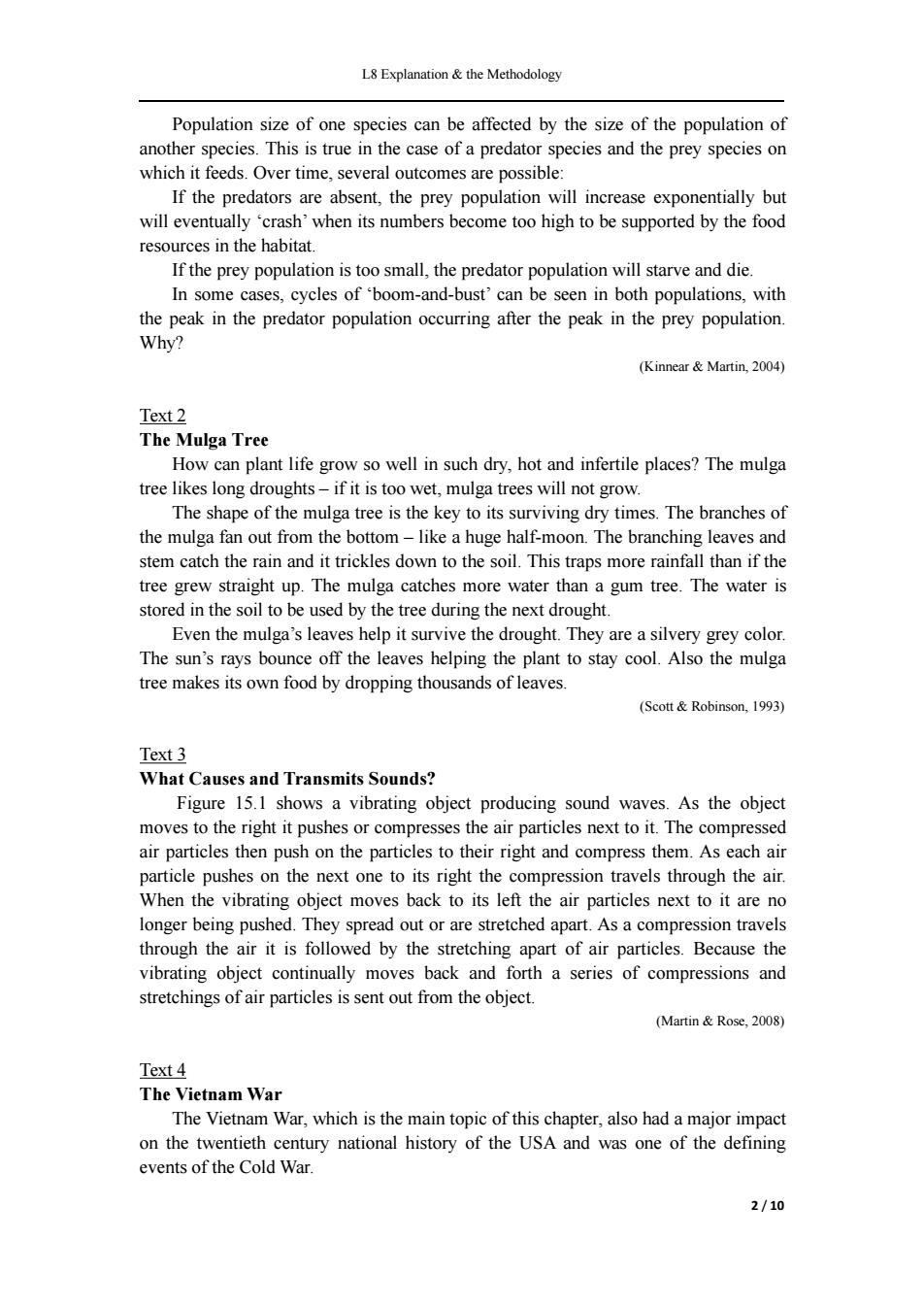正在加载图片...

L8 Explanation&the Methodology Population size of one species can be affected by the size of the population of another species.This is true in the case of a predator species and the prey species on which it feeds.Over time,several outcomes are possible: If the predators are absent,the prey population will increase exponentially but will eventually crash'when its numbers become too high to be supported by the food resources in the habitat. If the prey population is too small,the predator population will starve and die. In some cases,cycles of boom-and-bust'can be seen in both populations,with the peak in the predator population occurring after the peak in the prey population. Why? (Kinnear Martin,2004) Text 2 The Mulga Tree How can plant life grow so well in such dry,hot and infertile places?The mulga tree likes long droughts-if it is too wet,mulga trees will not grow. The shape of the mulga tree is the key to its surviving dry times.The branches of the mulga fan out from the bottom-like a huge half-moon.The branching leaves and stem catch the rain and it trickles down to the soil.This traps more rainfall than if the tree grew straight up.The mulga catches more water than a gum tree.The water is stored in the soil to be used by the tree during the next drought. Even the mulga's leaves help it survive the drought.They are a silvery grey color. The sun's rays bounce off the leaves helping the plant to stay cool.Also the mulga tree makes its own food by dropping thousands of leaves. (Scott Robinson,1993) Text 3 What Causes and Transmits Sounds? Figure 15.1 shows a vibrating object producing sound waves.As the object moves to the right it pushes or compresses the air particles next to it.The compressed air particles then push on the particles to their right and compress them.As each air particle pushes on the next one to its right the compression travels through the air. When the vibrating object moves back to its left the air particles next to it are no longer being pushed.They spread out or are stretched apart.As a compression travels through the air it is followed by the stretching apart of air particles.Because the vibrating object continually moves back and forth a series of compressions and stretchings of air particles is sent out from the object. (Martin Rose,2008) Text 4 The Vietnam War The Vietnam War,which is the main topic of this chapter,also had a major impact on the twentieth century national history of the USA and was one of the defining events of the Cold War. 2/10L8 Explanation & the Methodology 2 / 10 Population size of one species can be affected by the size of the population of another species. This is true in the case of a predator species and the prey species on which it feeds. Over time, several outcomes are possible: If the predators are absent, the prey population will increase exponentially but will eventually ‘crash’ when its numbers become too high to be supported by the food resources in the habitat. If the prey population is too small, the predator population will starve and die. In some cases, cycles of ‘boom-and-bust’ can be seen in both populations, with the peak in the predator population occurring after the peak in the prey population. Why? (Kinnear & Martin, 2004) Text 2 The Mulga Tree How can plant life grow so well in such dry, hot and infertile places? The mulga tree likes long droughts – if it is too wet, mulga trees will not grow. The shape of the mulga tree is the key to its surviving dry times. The branches of the mulga fan out from the bottom – like a huge half-moon. The branching leaves and stem catch the rain and it trickles down to the soil. This traps more rainfall than if the tree grew straight up. The mulga catches more water than a gum tree. The water is stored in the soil to be used by the tree during the next drought. Even the mulga’s leaves help it survive the drought. They are a silvery grey color. The sun’s rays bounce off the leaves helping the plant to stay cool. Also the mulga tree makes its own food by dropping thousands of leaves. (Scott & Robinson, 1993) Text 3 What Causes and Transmits Sounds? Figure 15.1 shows a vibrating object producing sound waves. As the object moves to the right it pushes or compresses the air particles next to it. The compressed air particles then push on the particles to their right and compress them. As each air particle pushes on the next one to its right the compression travels through the air. When the vibrating object moves back to its left the air particles next to it are no longer being pushed. They spread out or are stretched apart. As a compression travels through the air it is followed by the stretching apart of air particles. Because the vibrating object continually moves back and forth a series of compressions and stretchings of air particles is sent out from the object. (Martin & Rose, 2008) Text 4 The Vietnam War The Vietnam War, which is the main topic of this chapter, also had a major impact on the twentieth century national history of the USA and was one of the defining events of the Cold War